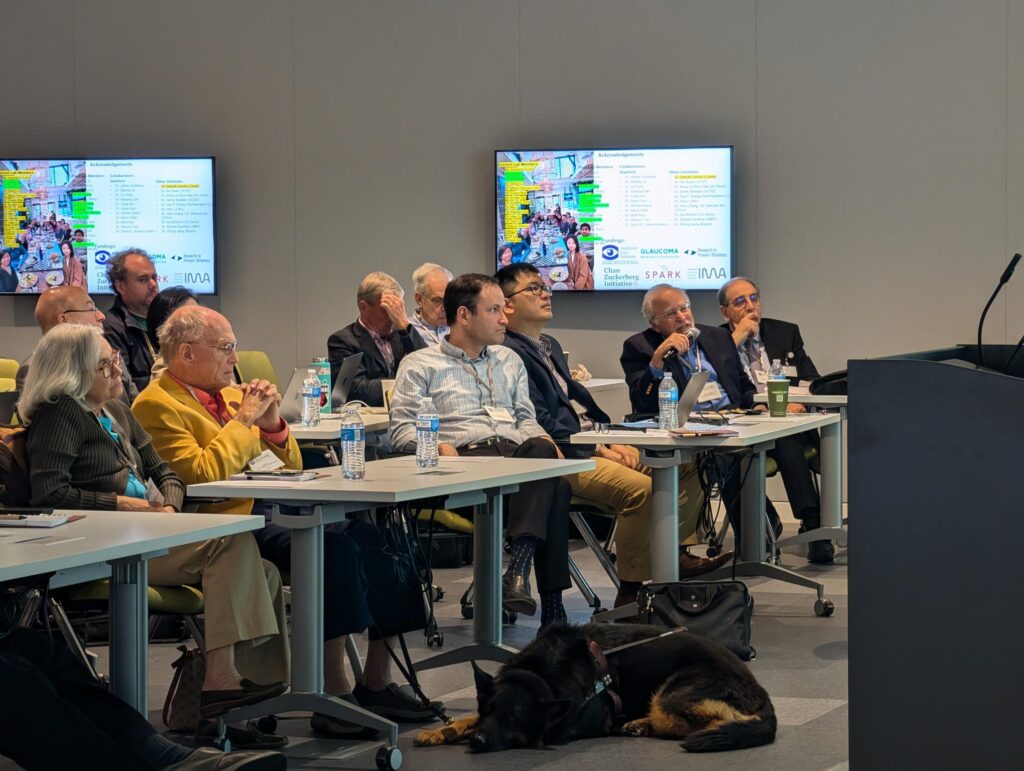The 13th annual Louis J. Fox Center for Vision Restoration Conference was held at the Vision Institute at UPMC Mercy Pavilion October 8-9, 2024. For the first time, the pathways towards clinical trials were discussed in terms of what to consider in getting research ready for that stage. While there is still a way to go, this illustrates the progress being made.
The meeting was organized by University of Pittsburgh faculty members Takaaki Kuwajima, PhD; Kun-Che Chang, PhD; Issam Al diri, PhD; Larry Benowitz, PhD; and John Ash, PhD. It attracted well over 80 attendees that included scientists, students, postdocs, ophthalmologists, and philanthropists.
For two full-days, cutting-edge research was presented on optic nerve preservation and regeneration. The conference featured an outstanding keynote presentation by Zhigang He from Harvard Medical School and Boston Children’s Hospital. There were an additional 25 speakers who are world leaders in the field who came from prestigious institutions, including Harvard, Stanford, the University of Pennsylvania, Washington University, Johns Hopkins Hospital, the Wilmer Eye Institute, UCSF, and the University of Pittsburgh.
“This conference is getting even better every year,” said José-Alain Sahel, Director of the Vision Institute and Chair, Department of Ophthalmology. “It was clear that major progress has been made in developing therapies to regenerate the optic nerve. This year, new transformative science from related but different fields was shared. The partnership with the Gilbert Family Foundation, Brightfocus, the Glaucoma Foundation, and the start of the upcoming ARPA-H program hold immense promise.”
Exciting new research was presented on developing new gene and stem-cell therapies to promote ganglion cell survival and regeneration of damaged axons. Multiple new approaches were presented. For the first time, researchers showed promising results of axon regeneration from the damaged nerve to the brain with modest vision restoration in preclinical models. Also, for the first time, clinical trial data was presented for gene therapies to treat optic neuropathies, and additional speakers discussed strategies to overcome barriers to developing new clinical trials.
In his concluding comments, Dr. Benowitz said, “We’re in a very, very exciting era, and thanks to the work of people in this room, I think the future is looking sunnier.” Interviews with additional attendees included similar praise for the meeting and optimism for the field.
“[All the speakers] say this has become one of the more important meetings each year for the field, because it’s very focused on optic nerve regeneration alone,” said Lawton Snyder, Eye &opti Ear Foundation CEO.
Leonard Levin viewed the conference as a chance to catch up in the field he’s part of. It was also an opportunity to see where the leaders – many of whom are friends – are at. “We’re getting the cutting-edge work told to us, even before it’s published in many cases,” he said. He described the community as close, because they all have the same goal to restore vision.
“A big theme from the two-day conference was that advancements have been made in all areas,” said Lawton Snyder, Eye & Ear Foundation CEO. “As Larry Benowitz (Co-Director of the Fox Center) stated in his remarks, ‘The work 20 years ago when this all started looks very different than it does today.’” This includes multiple modalities having a profound impact on optic nerve regeneration.
Jeff Gross said this conference and past Fox Center conferences have really pushed the field forward. He praised the synergy that occurs in bringing everyone together, saying so much more progress comes after the meeting as a result.
In a conversation with Snyder, Louis J. Fox said he and José-Alain Sahel, MD, Chair of the Department of Ophthalmology, have a similar view. They do not like the word no. He said the researchers and clinicians come self-motivated. It is not about the money or fame; it is about the idea of getting the job done. Everyone is working toward the same goal.
“It’s exciting to see new and unpublished work showing promising discoveries in optic nerve regeneration,” Dr. Ash said. “While there is still a long way to go, research presented at the meeting demonstrated significant progress in the field. Every year, we are getting closer to restoring functional vision to patients with optic nerve injury.”
